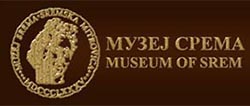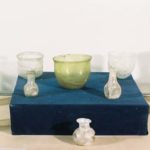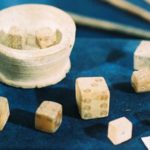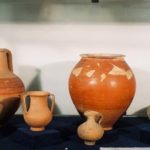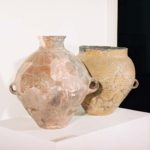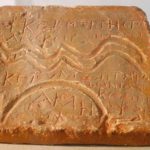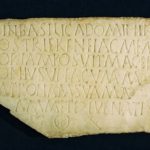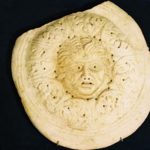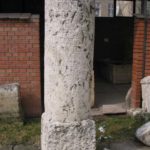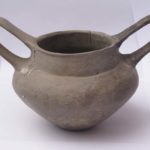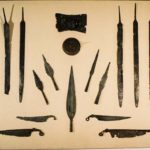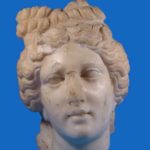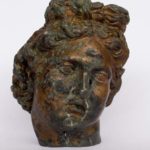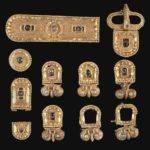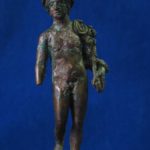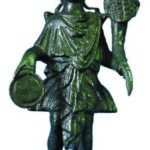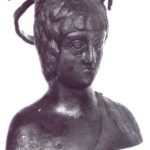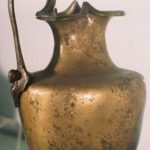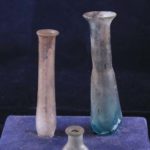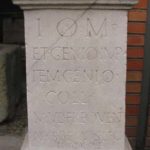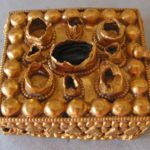ANTIQUE
CERAMICS COLLECTION – six decades of research on Sirmium contribute to an extremely rich inflow of ceramic material into the funds of the Museum of Srem. This type of material is very important from the aspect of chronological and usable determination of certain spaces that have been researched so far and are measured in hundreds of thousands of fragments. Through the typology and introduction of a new system of processing Roman ceramics, created thanks to Ana Premk, MA, from the Archaeological Institute Belgrade in the 1970s. a rulebook on the analysis of this material was set up, which is now applied to all ancient sites in Serbia. The collection presents examples of pottery that is classified as a typole used in Sirmium in Roman times, from the luxurious Italian terra sigilate to the polished German pottery of the end of the city’s existence. Due to the volume, the material is placed in several depots and is sorted by researched localities, purchases and gifts are stored separately. The typology, which consists of specimens of bowls, pots, plates, cups, amphorae, pitos, jugs, lids, cups, strainers, incense burners, prosopomorphic vessels, patera, is located in a special depot where the newly arrived ceramic objects are processed.
STONE COLLECTION – this collection began to form in the 19th. century, when enthusiasts of the city of Mitrovica, with the support of the famous travel writer Felix Kanic, tried to found a museum. Although this idea did not give rise to more permanent accommodation at that time, it enabled several exceptional examples of stone monuments of different types to be preserved. With the material collected after the founding of the Museum of Srem, either excavations, accidental finds throughout Srem or a gift, an extremely rich collection of this type of cultural monuments was created, numbering more than two thousand objects, among which the most interesting is an exclusive example of a marble sundial with representations of Titan Atlas and hero Hercules strong In addition to tombstones (stelae, sarcophagi, tombstones, titles, early Christian tombstones), votive monuments (the most important are the altars from the Beneficiary Station outside the western ramparts of Sirmium), honorary ones, such as parade macaws and milestones, there are numerous examples of architects. in Sirmium they painted in a special way an imperial city with a stone that comes from all parts of the Roman Empire.
GLASS COLLECTION – from the very beginning of the settlement of Sirmium, the Romans brought, among other things, glass objects, various vessels that were used in everyday life, but also for cult purposes and during funeral rites. The earliest glass object in the collection is an urn that was found in a marble vessel for the cremated remains of the deceased in the western, Italian necropolis of Sirmium. Although glass is extremely sensitive and it is very difficult to preserve it in its original form, there are a large number of fragments of glass vessels found so far, so they have been the subject of several typological treatments of this material. It is interesting to note that in late antiquity, Sirmium also had its own workshops for the production of the local glass industry, which imported the base material already prepared. Namely, traces of glass furnaces were found on one of the Sirmium sites, on Žitni trg, which directly confirmed the local glass production.
METAL COLLECTION – a diverse collection of objects made of different metals, mostly iron and bronze, while other materials, such as gold, silver and lead, are less represented. In addition to items used for military purposes, such as weapons and equipment, military diplomas in the collection are numerous items from everyday life, such as jewelry, jewelry, various bronze and copper vessels, and there are religious items, such as lead icons, so-called . Danubian horseman. The most important collections in our area are agricultural tools, plows, axes, scythes, but also artisan tools, then hooks and measuring instruments.
COLLECTION OF LAMPS – about 1000 whole and fragmented lamps represent a great treasure of the ancient collection of the Museum of Srem. Lamps or wires were used to illuminate temples and private spaces, and special types have been used in Sirmium since the arrival of the Romans. In the beginning, they were simply brought as a commercial product from Italy itself and some represent exceptional examples of this manufactory, but later it grew into local production, so there are numerous finds of molds from which the lamps were made. In late antiquity, there was a well-organized production of lamps that were decorated with a special lead enamel and made with a new technique, on a winch. More than half of the lamps found belong to this production.
MEDIEVAL COLLECTION – due to the importance of Sirmium, less attention is paid to the medieval period in research, although this area had its exceptional significance during the Great Migration, with several exclusive finds, especially from the Germanic and Avar periods. The finding of a gold Avar belt (10 elements) weighing over 1 kg of gold is more than worthy of preserving the name of Sremska Mitrovica in historical annals.
CERAMICS COLLECTION 16-18 CENTURIES- Sremska Mitrovica is a city that has been continuously developing for almost 7000 years, under different names, but there has always been a continuity of settlement. Thus, the period of the 16th-18th century, which was historically marked by the domination of Turkey and then the Austro-Hungarian Empire, was marked by records and preserved architectural objects and numerous finds of ceramic vessels. For this reason, these vessels are classified typologically by categories, enabling further research into the processes of production, distribution and dominance in our area.


